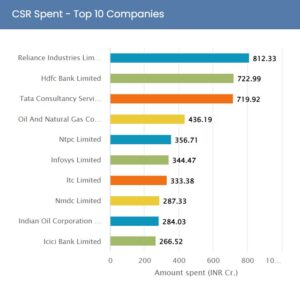
CSR spending by listed companies is declining, with unspent funds reaching a five-year high of Rs 1,475 crore during 2022-23. According to data from corporate tracker primeinfobase.com, companies were required to allocate Rs 15,787 crore to CSR activities but collectively spent only Rs 15,602 crore—Rs 185 crore short of the mandated amount. This shortfall arises partly because some companies overspent while others fell short of their required contributions. The Rs 1,475 crore represents the total unspent amount by companies that did not fulfil their CSR obligations, as reflected in their annual reports.
Under Indian law, companies meeting specific criteria based on net profit, turnover, and net worth must allocate at least 2% of their average net profits from the previous three financial years to CSR initiatives. These initiatives typically cover areas such as environmental sustainability, healthcare, skill development, drinking water, and sanitation. A decade ago, India became the first country in the world to mandate CSR by law—a revolutionary step at the time.
READ | Boosting FDI inflows: Solution lies in competitive federalism
A History of CSR Funding in India
Before the law was implemented in April 2014, corporate giving was largely voluntary and unregulated, though encouraged by the Ministry of Corporate Affairs. Historically, only a handful of companies engaged in social responsibility efforts, but many more were brought on board following the CSR law’s enactment.

This unique experiment unlocked significant capital for the social sector and the nation. From FY15 to FY22, a record Rs 1.5 lakh crore was channelled towards social impact through CSR. For a country with one of the highest income inequality gaps, these CSR funds became a boon, becoming the second-largest source of social sector funding in India, according to a 2022 Bridgespan Group report. It is projected that, at this momentum, CSR could channel an additional Rs 6.3 lakh crore for social development by 2033.
Over time, companies have learned to balance compliance with meaningful impact. Some CSR organisations now strive to create a positive influence on both society and their business. Projects with clear, measurable outcomes are prioritised, focusing on achieving fewer, more effective initiatives rather than spreading efforts too thin. Companies have also established dedicated Corporate Social Responsibility teams across various roles and functions.
The Present Picture
The data from primeinfobase.com covers all companies listed on the NSE and those exclusively listed on the BSE with a market capitalisation exceeding Rs 1,000 crore. In FY23, companies allocated Rs 99 for every Rs 100 mandated for CSR projects. Although this figure might not seem alarming, it is the lowest ratio in five years. By comparison, in FY20, companies spent Rs 111 for every Rs 100 required.
On average, each company spent Rs 11.29 crore on CSR in FY23, marking a 4% decrease from FY22 and a 9% decrease from FY21, when the coronavirus pandemic was at its peak. Overall, listed companies spent just 1.91% of their net profits on Corporate Social Responsibility, falling short of the 2% requirement. According to the National CSR Portal under the Ministry of Corporate Affairs, one in five companies—or a total of 4,855 companies—failed to meet the prescribed CSR expenditure in FY23. This trend raises concerns about the commitment of some listed companies to their social responsibilities, particularly in a year marked by economic challenges and rising social needs.
Despite the need for investment in underserved states with higher poverty levels and lower Sustainable Development Goals (SDG) scores, less than 2% of CSR funds currently reach districts identified as aspirational by the government. In contrast, wealthier states like Delhi, Goa, and Maharashtra receive the most CSR funding on a per capita basis.
There is a skewed distribution of Corporate Social Responsibility funds, with the majority being channelled into wealthier regions and sectors that have traditionally attracted more private investment. Over the past eight years, education and healthcare have been the most heavily funded sectors, while less than 1% of CSR expenditure has been directed towards addressing socio-economic inequalities. For CSR to drive population-level change, investments must be more equitably distributed, particularly to sectors that have historically not attracted private funding.
The Road Ahead
To ensure equitable access to funds, companies must adopt two key policies: scaling in and scaling out. Scaling in involves focusing on deeper, targeted impacts within select communities, particularly those surrounding factories or in aspirational districts, to address their comprehensive social needs. Scaling out entails expanding the reach of Corporate Social Responsibility initiatives to broader populations through national programs aimed at tackling the root causes of inequalities.
Companies should also seek to fund innovative solutions and support multi-year grants to create sustainable impact. For example, Bajaj Finserv’s partnership with Neomotion, a startup that develops wheelchairs and vehicles for the differently abled, demonstrates how CSR can catalyse innovation. Similarly, the Nanhi Kali project, backed by multi-year support from the KC Mahindra Education Trust, has grown from supporting 2,000 girls in 2012 to impacting nearly 20 lakh girls today.
The successful implementation of Corporate Social Responsibility fund in India has driven vital social change. As India’s economic growth continues, sustained efforts from CSR leaders, corporate boards, nonprofit partners, and the government will be crucial in addressing long-standing developmental and inequality challenges.
